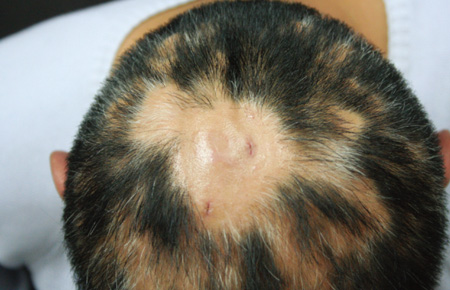Yonsei Med J.
2010 Jul;51(4):612-614. 10.3349/ymj.2010.51.4.612.
Cutis Verticis Gyrata and Alopecia Areata: A Synchronous Coincidence?
- Affiliations
-
- 1Department of Dermatology, College of Medicine, Chung-Ang University, Seoul, Korea. drseo@hanafos.com
- KMID: 1805206
- DOI: http://doi.org/10.3349/ymj.2010.51.4.612
Abstract
- Cutis verticis gyrata (CVG) is a descriptive term for a scalp condition that is convoluted folds and deep furrows that resemble the surface of the cerebral cortex. It is categorized by the underlying etiology, as primary essential, primary non-essential and secondary. Alopecia areata (AA) is a common, organ specific autoimmune disease, and most AA cases are sporadic. There is clearly a strong genetic component. There is no established relationship between CVG and AA. We report one case which was affected with essential primary CVG and alopecia areata, and suggest a possibility of genetic association between CVG and AA, possibly both being related to mutations in the fibroblast growth factor receptor 2 (FGFR2).
Figure
Reference
-
1. Diven DG, Tanus T, Raimer SS. Cutis verticis gyrata. Int J Dermatol. 1991. 30:710–712.
Article2. Safavi KH, Muller SA, Suman VJ, Moshell AN, Melton LJ 3rd. Incidence of alopecia areata in Olmsted Country, Minnesota, 1975 through 1989. Mayo Clin Proc. 1995. 70:628–633.
Article3. Claude SB, Vaishali E. Jeffrey PC, Thomas DH, Anthony JM, Stuart JS, Julie VS, Thomas S, editors. Dermal hypertrophies. Bolognia dermatology. 2008. 2nd ed. Philadelphia: Mosby Elsevier;1502.4. Synder MC, Johnson PJ, Hollins RR. Congenital primary cutis verticis gyrata. Plast Reconstr Surg. 2002. 110:818–821.
Article5. Schenato LK, Gil T, Carvalho LA, Ricachnevsky N, Sanseverino A, Halpern R. [Essential primary cutis verticis gyrata]. J Pediatr (RiO J). 2002. 78:75–80.
Article6. Tan O, Ergen D. Primary essential cutis verticis gyrata in an adult female patient: a case report. J Dermatol. 2006. 33:492–495.
Article7. Larsen F, Birchall N. Cutis verticis gyrata: three cases with different aetiologies that demonstrate the classification system. Australas J Dermatol. 2007. 48:91–94.8. Meyer KB, Maia AT, O'Reilly M, Teschendorff AE, Chin SF, Caldas C, et al. Allele-specific up-regulation of FGFR2 increases susceptibility to breast cancer. PLoS Biol. 2008. 6:e108.
Article9. Akira S, Isshiki H, Sugita T, Tanabe O, Kinoshita S, Nishio Y, et al. A nuclear factor for IL-6 expression (NF-IL6) is a member of a C/EBP family. EMBO J. 1990. 9:1897–1906.
Article10. Li Y, Bäckesjö CM, Haldosén LA, Lindgren U. IL-6 receptor expression and IL-6 effects change during osteoblast differentiation. Cytokine. 2008. 43:165–173.
Article11. Gilhar A, Paus R, Kalish RS. Lymphocytes, neuropeptides, and genes involved in alopecia areata. J Clin Invest. 2007. 117:2019–2027.
Article



